[English] 日本語
 Yorodumi
Yorodumi- PDB-3lzb: EGFR kinase domain complexed with an imidazo[2,1-b]thiazole inhibitor -
+ Open data
Open data
- Basic information
Basic information
| Entry | Database: PDB / ID: 3lzb | ||||||
|---|---|---|---|---|---|---|---|
| Title | EGFR kinase domain complexed with an imidazo[2,1-b]thiazole inhibitor | ||||||
 Components Components | Epidermal growth factor receptor | ||||||
 Keywords Keywords | TRANSFERASE/TRANSFERASE INHIBITOR / epidermal growth factor kinase domain / multitargeted small molecule kinase inhibitor / TRANSFERASE-TRANSFERASE INHIBITOR complex | ||||||
| Function / homology |  Function and homology information Function and homology informationmultivesicular body, internal vesicle lumen / negative regulation of cardiocyte differentiation / Shc-EGFR complex / positive regulation of protein kinase C signaling / Inhibition of Signaling by Overexpressed EGFR / epidermal growth factor receptor activity / EGFR interacts with phospholipase C-gamma / regulation of peptidyl-tyrosine phosphorylation / epidermal growth factor binding / response to UV-A ...multivesicular body, internal vesicle lumen / negative regulation of cardiocyte differentiation / Shc-EGFR complex / positive regulation of protein kinase C signaling / Inhibition of Signaling by Overexpressed EGFR / epidermal growth factor receptor activity / EGFR interacts with phospholipase C-gamma / regulation of peptidyl-tyrosine phosphorylation / epidermal growth factor binding / response to UV-A / PLCG1 events in ERBB2 signaling / ERBB2-EGFR signaling pathway / morphogenesis of an epithelial fold / PTK6 promotes HIF1A stabilization / ERBB2 Activates PTK6 Signaling / digestive tract morphogenesis / Signaling by EGFR / intracellular vesicle / negative regulation of epidermal growth factor receptor signaling pathway / eyelid development in camera-type eye / cerebral cortex cell migration / protein insertion into membrane / ERBB2 Regulates Cell Motility / protein tyrosine kinase activator activity / Respiratory syncytial virus (RSV) attachment and entry / Signaling by ERBB4 / PI3K events in ERBB2 signaling / positive regulation of phosphorylation / positive regulation of peptidyl-serine phosphorylation / Estrogen-dependent nuclear events downstream of ESR-membrane signaling / hair follicle development / MAP kinase kinase kinase activity / GAB1 signalosome / positive regulation of G1/S transition of mitotic cell cycle / embryonic placenta development / salivary gland morphogenesis / Signaling by ERBB2 / TFAP2 (AP-2) family regulates transcription of growth factors and their receptors / GRB2 events in EGFR signaling / SHC1 events in EGFR signaling / transmembrane receptor protein tyrosine kinase activity / EGFR Transactivation by Gastrin / GRB2 events in ERBB2 signaling / ossification / SHC1 events in ERBB2 signaling / basal plasma membrane / cellular response to epidermal growth factor stimulus / positive regulation of DNA repair / positive regulation of DNA replication / epithelial cell proliferation / Signal transduction by L1 / positive regulation of epithelial cell proliferation / positive regulation of protein localization to plasma membrane / NOTCH3 Activation and Transmission of Signal to the Nucleus / cellular response to amino acid stimulus / phosphatidylinositol 3-kinase/protein kinase B signal transduction / cellular response to estradiol stimulus / EGFR downregulation / clathrin-coated endocytic vesicle membrane / Signaling by ERBB2 TMD/JMD mutants / Constitutive Signaling by EGFRvIII / cell-cell adhesion / receptor protein-tyrosine kinase / Signaling by ERBB2 ECD mutants / negative regulation of protein catabolic process / Signaling by ERBB2 KD Mutants / positive regulation of miRNA transcription / kinase binding / ruffle membrane / Downregulation of ERBB2 signaling / epidermal growth factor receptor signaling pathway / positive regulation of fibroblast proliferation / cell morphogenesis / positive regulation of protein phosphorylation / neuron differentiation / HCMV Early Events / Constitutive Signaling by Aberrant PI3K in Cancer / actin filament binding / cell junction / transmembrane signaling receptor activity / positive regulation of canonical Wnt signaling pathway / Cargo recognition for clathrin-mediated endocytosis / PIP3 activates AKT signaling / Constitutive Signaling by Ligand-Responsive EGFR Cancer Variants / Clathrin-mediated endocytosis / virus receptor activity / ATPase binding / PI5P, PP2A and IER3 Regulate PI3K/AKT Signaling / RAF/MAP kinase cascade / positive regulation of cell growth / double-stranded DNA binding / protein tyrosine kinase activity / early endosome membrane / protein phosphatase binding / nuclear membrane / basolateral plasma membrane / learning or memory / cell surface receptor signaling pathway / Extra-nuclear estrogen signaling / positive regulation of ERK1 and ERK2 cascade Similarity search - Function | ||||||
| Biological species |  Homo sapiens (human) Homo sapiens (human) | ||||||
| Method |  X-RAY DIFFRACTION / X-RAY DIFFRACTION /  SYNCHROTRON / SYNCHROTRON /  MOLECULAR REPLACEMENT / Resolution: 2.7 Å MOLECULAR REPLACEMENT / Resolution: 2.7 Å | ||||||
 Authors Authors | Swinger, K.K. | ||||||
 Citation Citation |  Journal: Bioorg.Med.Chem.Lett. / Year: 2010 Journal: Bioorg.Med.Chem.Lett. / Year: 2010Title: Imidazo[2,1-b]thiazoles: multitargeted inhibitors of both the insulin-like growth factor receptor and members of the epidermal growth factor family of receptor tyrosine kinases. Authors: Fidanze, S.D. / Erickson, S.A. / Wang, G.T. / Mantei, R. / Clark, R.F. / Sorensen, B.K. / Bamaung, N.Y. / Kovar, P. / Johnson, E.F. / Swinger, K.K. / Stewart, K.D. / Zhang, Q. / Tucker, L.A. ...Authors: Fidanze, S.D. / Erickson, S.A. / Wang, G.T. / Mantei, R. / Clark, R.F. / Sorensen, B.K. / Bamaung, N.Y. / Kovar, P. / Johnson, E.F. / Swinger, K.K. / Stewart, K.D. / Zhang, Q. / Tucker, L.A. / Pappano, W.N. / Wilsbacher, J.L. / Wang, J. / Sheppard, G.S. / Bell, R.L. / Davidsen, S.K. / Hubbard, R.D. | ||||||
| History |
|
- Structure visualization
Structure visualization
| Structure viewer | Molecule:  Molmil Molmil Jmol/JSmol Jmol/JSmol |
|---|
- Downloads & links
Downloads & links
- Download
Download
| PDBx/mmCIF format |  3lzb.cif.gz 3lzb.cif.gz | 248.6 KB | Display |  PDBx/mmCIF format PDBx/mmCIF format |
|---|---|---|---|---|
| PDB format |  pdb3lzb.ent.gz pdb3lzb.ent.gz | 189.9 KB | Display |  PDB format PDB format |
| PDBx/mmJSON format |  3lzb.json.gz 3lzb.json.gz | Tree view |  PDBx/mmJSON format PDBx/mmJSON format | |
| Others |  Other downloads Other downloads |
-Validation report
| Summary document |  3lzb_validation.pdf.gz 3lzb_validation.pdf.gz | 1.4 MB | Display |  wwPDB validaton report wwPDB validaton report |
|---|---|---|---|---|
| Full document |  3lzb_full_validation.pdf.gz 3lzb_full_validation.pdf.gz | 1.5 MB | Display | |
| Data in XML |  3lzb_validation.xml.gz 3lzb_validation.xml.gz | 48.3 KB | Display | |
| Data in CIF |  3lzb_validation.cif.gz 3lzb_validation.cif.gz | 64.1 KB | Display | |
| Arichive directory |  https://data.pdbj.org/pub/pdb/validation_reports/lz/3lzb https://data.pdbj.org/pub/pdb/validation_reports/lz/3lzb ftp://data.pdbj.org/pub/pdb/validation_reports/lz/3lzb ftp://data.pdbj.org/pub/pdb/validation_reports/lz/3lzb | HTTPS FTP |
-Related structure data
| Related structure data | 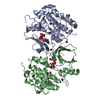 2gs7S S: Starting model for refinement |
|---|---|
| Similar structure data |
- Links
Links
- Assembly
Assembly
| Deposited unit | 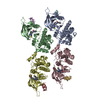
| ||||||||
|---|---|---|---|---|---|---|---|---|---|
| 1 | 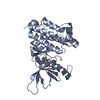
| ||||||||
| 2 | 
| ||||||||
| 3 | 
| ||||||||
| 4 | 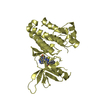
| ||||||||
| 5 | 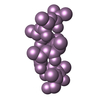
| ||||||||
| 6 | 
| ||||||||
| 7 | 
| ||||||||
| 8 | 
| ||||||||
| Unit cell |
|
- Components
Components
| #1: Protein | Mass: 36137.484 Da / Num. of mol.: 8 / Fragment: UNP residues 696-1022 / Mutation: V924R Source method: isolated from a genetically manipulated source Source: (gene. exp.)  Homo sapiens (human) / Gene: EGFR, ERBB1 / Production host: Homo sapiens (human) / Gene: EGFR, ERBB1 / Production host:  References: UniProt: P00533, receptor protein-tyrosine kinase #2: Chemical | ChemComp-ITI / #3: Water | ChemComp-HOH / | Sequence details | THE ACTUAL CRYSTALLIZED SEQUENCE FOR THE LAST 39 C-TERMINAL RESIDUES IS ...THE ACTUAL CRYSTALLIZ | |
|---|
-Experimental details
-Experiment
| Experiment | Method:  X-RAY DIFFRACTION / Number of used crystals: 1 X-RAY DIFFRACTION / Number of used crystals: 1 |
|---|
- Sample preparation
Sample preparation
| Crystal grow | Temperature: 290 K / Method: vapor diffusion, sitting drop / pH: 7.7 Details: 0.15M cesium chloride, 15% w/v polyethylene glycol 3350, pH 7.7, VAPOR DIFFUSION, SITTING DROP, temperature 290K |
|---|
-Data collection
| Diffraction | Mean temperature: 77 K |
|---|---|
| Diffraction source | Source:  SYNCHROTRON / Site: SYNCHROTRON / Site:  APS APS  / Beamline: 17-BM / Wavelength: 1 Å / Beamline: 17-BM / Wavelength: 1 Å |
| Detector | Type: ADSC QUANTUM 210 / Detector: CCD / Date: Jun 3, 2009 / Details: mirrors |
| Radiation | Protocol: SINGLE WAVELENGTH / Monochromatic (M) / Laue (L): M / Scattering type: x-ray |
| Radiation wavelength | Wavelength: 1 Å / Relative weight: 1 |
| Reflection | Resolution: 2.7→50 Å / Num. all: 36061 / Num. obs: 36046 / % possible obs: 99.8 % / Redundancy: 3.7 % / Biso Wilson estimate: 62.974 Å2 / Rmerge(I) obs: 0.131 / Rsym value: 0.131 / Net I/σ(I): 13.55 |
| Reflection shell | Resolution: 2.7→2.8 Å / Redundancy: 3.6 % / Rmerge(I) obs: 0.52 / Mean I/σ(I) obs: 2.1 / Num. unique all: 3571 / Rsym value: 0.52 / % possible all: 76 |
- Processing
Processing
| Software |
| ||||||||||||||||||||||||||||||||||||||||||||||||||
|---|---|---|---|---|---|---|---|---|---|---|---|---|---|---|---|---|---|---|---|---|---|---|---|---|---|---|---|---|---|---|---|---|---|---|---|---|---|---|---|---|---|---|---|---|---|---|---|---|---|---|---|
| Refinement | Method to determine structure:  MOLECULAR REPLACEMENT MOLECULAR REPLACEMENTStarting model: PDB ENTRY 2GS7 Resolution: 2.7→44.17 Å / Cross valid method: THROUGHOUT / σ(F): 2.7 / σ(I): 2.7
| ||||||||||||||||||||||||||||||||||||||||||||||||||
| Displacement parameters | Biso mean: 57.9 Å2
| ||||||||||||||||||||||||||||||||||||||||||||||||||
| Refinement step | Cycle: LAST / Resolution: 2.7→44.17 Å
| ||||||||||||||||||||||||||||||||||||||||||||||||||
| Refine LS restraints |
| ||||||||||||||||||||||||||||||||||||||||||||||||||
| LS refinement shell | Resolution: 2.7→2.8 Å / Total num. of bins used: 9
|
 Movie
Movie Controller
Controller


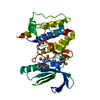
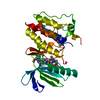
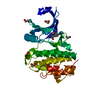
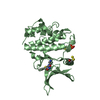

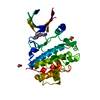


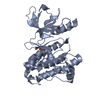

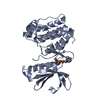

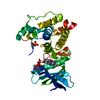
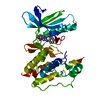
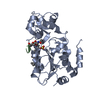

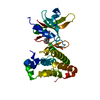
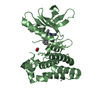
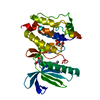
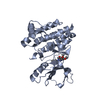
 PDBj
PDBj















